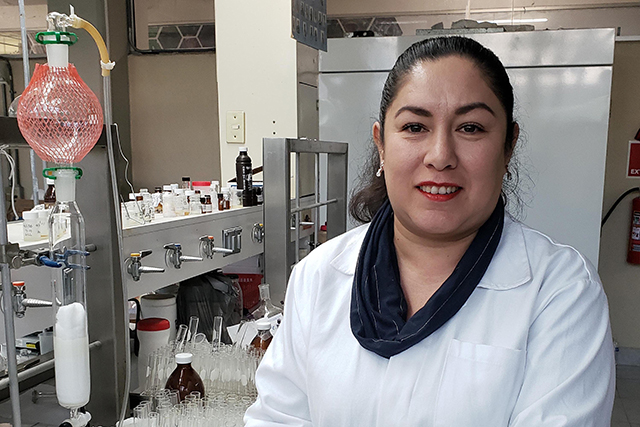- The proposal has been tested in breast and cervical cancer, the first and second leading cause of death from malignant neoplasms in women
Worldwide, various research groups are working on the search for new anticancer therapies to address a public health problem that causes more than 8 million deaths a year. BUAP researchers synthesize new steroidal molecules and their precursors (intermediate compounds) to whose structure they add nitrogen to repress the metastatic capacity of tumor cells. The compounds have been tested in breast and cervical cancer, the first and second leading cause of death from malignant neoplasms in women.
Participating in this research are doctors Maura Cárdenas García, from the Faculty of Medicine; Sylvain Bernès, from the “Luis Rivera Terrazas” Institute of Physics (IFUAP); and María Guadalupe Hernández Linares, from the Institute of Sciences (ICUAP). Likewise, doctors Luis Sánchez, from UNAM, and Marieta Fernández Herrera, from Cinvestav-Unidad Mérida; and graduate students Gabriel Guerrero Luna and Alejandra Ortiz González; and undergraduate degrees from BUAP, Jaquelín Reyes, from Biotechnology, and Alejandra Ortiz, from Medicine, among others.
The addition of a nitrogen group to the steroid molecule favors a greater antiproliferative activity in cancer cell lines. Therefore, these compounds are versatile and active in different types of carcinoma, so their scope is wide.
Dr. María Guadalupe Hernández Linares, level I of the National System of Researchers of Conacyt, asserts that the molecules developed are active in cervical cancer cell lines (HeLa and CasKi) and breast (subtypes MCF-7 and MDA-MB-231) , both hormone and non-hormone dependent. This last subtype is a valuable model for triple negative breast cancer research, because it is the one with the worst prognosis, since the treatments are usually not effective.
“These results will allow the design of compounds that effectively inhibit or reduce the metastatic capacity of these tumor cells and this will translate into better quality and life expectancy. Likewise, we have results in colon cancer lines (HCT-15) and as soon as we return to the laboratory we will work on prostate cancer cell lines ”.
Hernández Linares, president of the Mexican Academy of Organic Chemistry AC (AMQO), adds that in addition to selective antiproliferative activity, nitrogenous steroidal compounds have shown that they are not cytotoxic in healthy cells, making them a therapeutic option against cancer and with fewer side effects.
From this research derives the registration of three patent applications, the publication of two indexed articles in international journals and two more articles under review, as well as the training of specialized students in this research topic, through undergraduate and graduate thesis.
Short and green methodology
María Guadalupe Hernández Linares, PhD in Chemical Sciences from BUAP, has worked on this line of research for more than 15 years, previously at the Universidad del Istmo, in Oaxaca. “I always had the idea that steroidal nitrogenous compounds would be very useful as anticancer or antibiotic. It is enough to see that in nature many active compounds contain these same functional groups in the form of amines, oximes, amides and isoxazoles ”.
His work consists of extracting natural compounds from plants, to modify them through reactions that allow adding other groups of atoms to the chemical structure -in this case nitrogen-, in order to increase their potential biological activity.
The raw material is a steroid called diosgenin, it comes from a plant native to Mexico known as barbasco (Dioscorea mexicana), rich in steroidal saponins that are extracted from this tuber (root) and which are treated in an acid medium to obtain sapogenins (diosgenin), in turn these are transformed into other new and more active steroids.
The ICUAP researcher, who is also a founding member of the Mexican Association for Research in Natural Products, and also collaborates with the Botanical Garden in its Research Laboratory, emphasizes that the designs of the synthesis routes of these nitrogenous derivatives are carried out in a few steps and with green methodologies, by reducing the use of solvents and the reaction time. This allows to obtain compounds faster and in sufficient quantities for their evaluation.
“For example, in the case of triple negative breast cancer (MDA-MB-231) we have seen a good response with our new nitrogenous steroidal compounds. This cancer is called triple negative because its cells do not contain estrogen or progesterone receptors, nor do they produce excess HER2 protein (their tests are negative for these three receptors) and treatments usually do not give good results, due to their limited response. cells with currently available drugs ”.
Cancer is the third leading cause of death in Mexico: it represents 12 percent of deaths. Hence the importance of discovering new therapeutic agents that effectively suppress the metastatic capacity of tumor cells, to achieve a better quality and life expectancy in patients, indicates Dr. Hernández Linares, 2014 State Prize for Science, Technology and Innovation.
–


